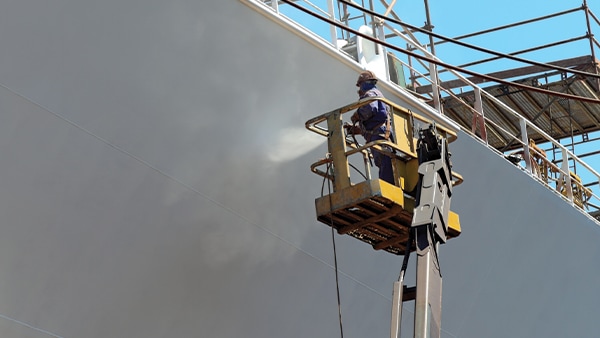At a glance
Shipyard workers are involved in the manufacture, repair, maintenance, and dismantling of boats and ships. Workers in this industry are exposed to a variety of chemical and physical hazards that can cause acute and chronic diseases. Fatality and injury rates for shipyard workers are higher than the national average.

Overview
Shipyard workers are involved in the manufacture, repair, maintenance, and dismantling of boats and ships. The work involves activities such as welding and cutting steel, machining, plumbing, electrical work, rigging, applying and removing paint and other surface coatings, and cleanup of chemical and fuel residues.
There are a variety of workplace hazards found in shipyards. These include chemical hazards such as exposure to asbestos, welding fumes, metals, and a variety of paints, solvents, and fuels. There are also physical hazards such as noise exposure, extreme temperatures, vibration, awkward body positions, and the risk of musculoskeletal injuries. Hot work, confined space entry, exposure to hazardous air, and work done at height all increase the risk of injury. Shipyard workers may work above water while a vessel is docked, introducing a fall hazard that may lead to drowning.
Chronic illness is also a concern for long term shipyard workers. Respiratory illness caused by gas, vapor, and smoke inhalation and exposure to heavy metals, such as lead, are of particular concern in shipyard workers. Excess cancer morbidity has been detected in several groups of shipyard workers, especially cancers of the respiratory system,1234 with welders appearing to be at particular risk. 5Another study found an increased risk of leukemia in electricians and welders working in a naval nuclear shipyard.6 Shipyard workers have higher fatality and nonfatal injuries/illnesses rates than the rates for all U.S. workers.
There are approximately 165,000 workers7 employed in shipyards in the U.S., spread across 26 states bordering coastal and inland waters. Between 2011 and 2017, there were at least 45 fatal accidents (4.0 per 100,000) among shipyard workers,8 higher than the rate for all U.S. workers. There were an estimated 61,600 nonfatal injuries/illnesses during the same period (5,370 per 100,000), nearly twice the rate for all U.S. workers, and one of the highest injury/illness rates among maritime workers.9
- Blot WJ, Morris LE, Stroube R, Tagnon I, Fraumeni JF Jr [1980]. Lung and Laryngeal Cancers in Relation to Shipyard Employment in Coastal Virginia. J Natl Cancer Inst 65(3):571–575.
- Edge J [1979]. Incidence of bronchial carcinoma in shipyard workers with pleural plaques. Ann NY Acad Sci 330(1):289–294.
- Melkild A, Langard S, Andersen A, Tonnessen JN [1989]. Incidence of cancer among welders and other workers in a Norwegian shipyard. Scand J Work Environ Health 15(6):387–394.
- Sanden A, Jarvholm B [1987]. Cancer morbidity in Swedish shipyard workers 1978–1983. Int Arch Occup Environ Health 59(6):623.
- Danielsen TE, Langard S, Anderson A [1996]. Incidence of cancer among Norwegian boiler welders. Occup Environ Med 53(4):231–234.
- Stern FB, Waxweiler R, Beaumont J, Lee ST, Rinsky R, Zumwalde R, Halperin WE, Bierbaum PJ, Landrigan PJ, Murray JR WE [1986]. A case-control study of leukemia at a naval nuclear shipyard. Am J Epidemiol 123(6):980–992.
- BLS [2017]. NAICS 3366 ship and boat building, all U.S., all ownerships, 2006–2016. In Quarterly Census of Employment and Wages. Washington DC: U.S. Department of Labor, Bureau of Labor Statistics, https://data.bls.gov/cew/apps/data_views/data_views.htm#tab=Tables.
- BLS [2017]. NAICS 3366 Fatalities in all sectors, all U.S., all ownerships, 2011–2016. In Census of Fatal Occupational Injuries. Washington DC: U.S. Department of Labor, Bureau of Labor Statistics, https://www.bls.gov/data/#injuries.
- BLS [2017]. Table 2. Numbers of nonfatal occupational injuries and illnesses by industry and case types, 2011–2016. In Survey of Occupational Injuries and Illnesses. Washington DC: U.S. Department of Labor, Bureau of Labor Statistics, https://www.bls.gov/iif/oshsum.htm.
